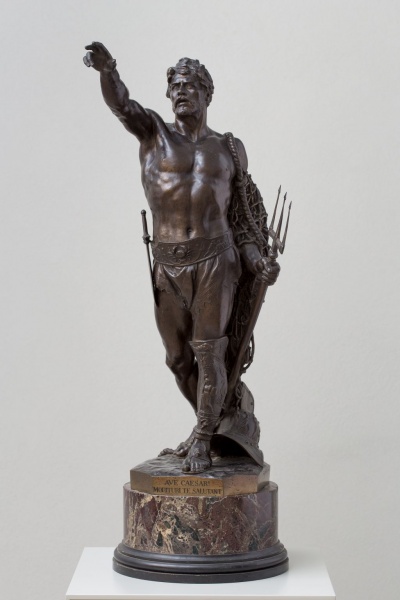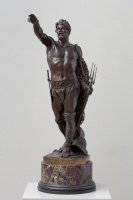
The Gladiator
| Author: |
Pius Weloński (1849–1931) |
| Created: | Second half of the 19th century |
| Material: | bronze, marble |
| Dimensions: | 81 × 32 cm |
| Signature: | inscription on the base front: AVE CAESAR! / MORITURI TE SALUTANT Signed on a postament: Pio Weloński Roma / Fond. Nelli. Roma |
Pijus Velionskis (Pius Weloński, 1849–1931) was a Lithuanian-born sculptor who achieved international recognition, and his work continues to be admired by connoisseurs of art. Born in Kumelionys near Marijampolė, his career took him from Warsaw and St Petersburg to other European capitals, and eventually to Rome, where he continued his art studies and started a family. In 1890 he returned to St Petersburg as a professor at the Academy of Fine Arts, where he spent several years before moving to Warsaw in 1899. He remained in Warsaw until his death, playing an active role in the city’s cultural life.
The Gladiator is one of Velionskis’ most famous and popular works, for which he was awarded the title of academician by St Petersburg’s Academy of Fine Arts. In addition, in 1891 the sculpture was awarded a gold medal at the international art exhibition in Berlin. It depicts a Roman gladiator, a retiarius who fought with a net, with his hand raised in a gesture that is explained by the Latin words inscribed on the pedestal Ave, Caesar, morituri te salutant (‘Hail, Emperor, those who are about to die salute you’). It was traditionally believed, although this is unfounded, that this was a slogan that gladiators addressed to the emperor before entering the arena. The theme from the history of Ancient Rome, which was common in academic art, may also have had a second hidden meaning of a call to battle for contemporaries of the artist. This interpretation is reinforced by the fact that the ‘slogan of the gladiators’ could also be heard, for example, in the early 19th century from Polish and Lithuanian cavalrymen fighting under Napoleon in the Somosierra Gorge in 1808.
The first version of The Gladiator was created by the young Velionskis in Rome in 1879 and 1880. A 180-centimetre-tall sculpture was cast in bronze in 1881 at the metal foundry of Alexander Nelli (1842–after 1903) known as Fonderia Nelli. Later, replicas of the sculpture were made in various sizes in different materials (marble and bronze). Large sculptures were placed in public spaces in Rome, Krakow and Warsaw, while small bronze versions made at the Fonderia Nelli in Rome found their way into private art collections. It is difficult to say how many copies of the sculpture were cast, but they can currently be found in various expositions around the world, from the National Museum in Kraków to the Victoria and Albert Museum in London, as well as in private collections.
Text author Rūta Janonienė
Source: Law firm Valiunas Ellex art album THE ART OF MATERIALS. Compiler and text author Jurgita Ludavičienė






